The recent Jetstar shutdown in Singapore caught many travellers off guard. It’s a clear reminder that even with the best travel planning, things can sometimes still go wrong.
Flight delays and cancellations are an unfortunate reality of modern air travel. While you can’t always avoid them, you can be prepared. Here’s what to do if your flight is delayed or cancelled, and how to protect yourself as a traveller.
Step 1: Pause to breathe
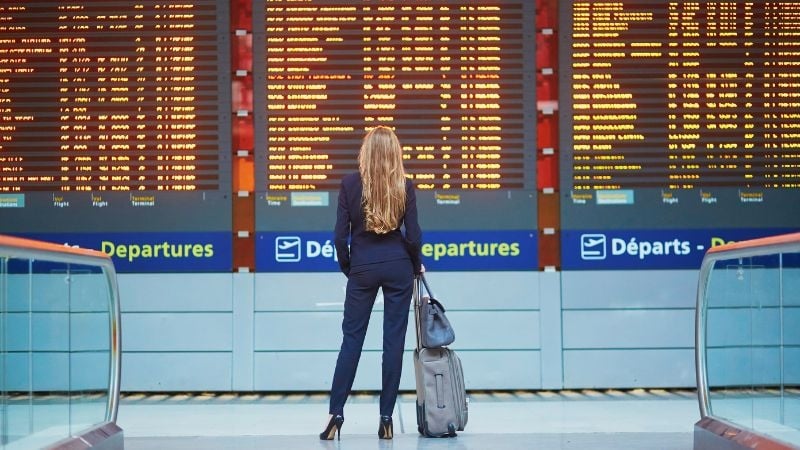
Image credit: Jaspe via Canva Pro
The first thing to do is a cliché, but has to be said: don’t panic. You might feel rushed to jump into action immediately, but it often works wonders to take a quick breath first to stay level-headed. This will help you think logically and make better decisions in a chaotic situation.
Take a moment to check your surroundings, charge your phone if needed, then start gathering information.
Step 2: Confirm the disruption
Before you head to the counter or start making calls, verify the exact status of your flight. Confirm whether the flight is facing a simple delay or has been officially cancelled. Check how long the delay is expected to last, and whether the airline has already rebooked or rescheduled the flight on your behalf.
You can check these with:
- Your airline’s mobile app or website
- Text or email notifications from the airline
- Airport departure boards
- Flight tracking apps
- Airport staff at the information desk or the boarding gate
Step 3: Head to the airline desk, or call if it’s crowded
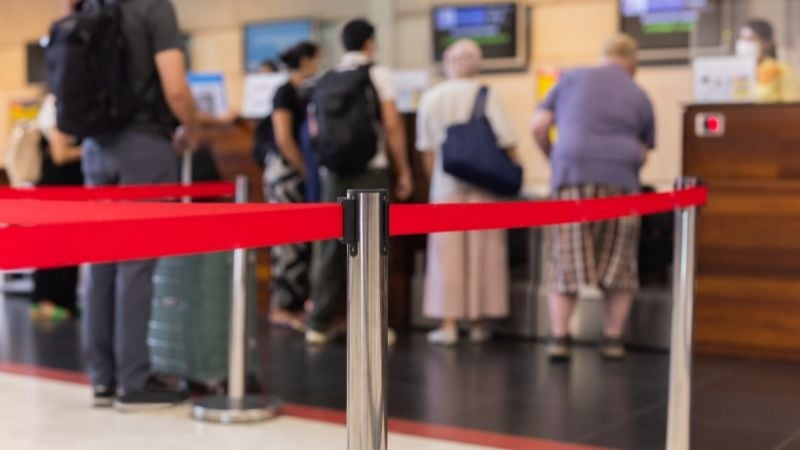
Image credit: Suwinai Sukanant via Canva Pro
Once you’ve confirmed the situation, the next step is to speak with your airline. If you’re already at the airport, go directly to the airline’s customer service or transfer desk. In many cases, they’ll be the only ones able to rebook you or offer alternatives.
But queues can be long, especially during mass delays or shutdowns. If that’s the case, try calling the airline’s customer service hotline or using the app’s chat function. Airlines sometimes have separate teams handling digital requests, which can speed things up.
Have your booking reference and passport details ready; it’ll make the process smoother. And above all, treat staff with respect and patience. They are your best bet at resolving the issue efficiently, and a little kindness goes a long way.
Step 4: Understand your options

Image credit: yuriz via Canva Pro
Airlines typically offer a few remedies when things go wrong, and it’s important to understand what you’re entitled to.
If your flight is cancelled, most airlines will allow you to:
- Rebook on the next available flight, either with them or a partner carrier
- Get a full refund to your original payment method
- Accept a travel voucher or flight credit (sometimes with a bonus value)
Ask for all available options before making a decision. In some cases, especially when the delay or cancellation is the airline’s fault, you may also be entitled to meal vouchers, hotel accommodation, or ground transport.
Also read: SIA and Scoot to Launch Replacement Flights After Jetstar Asia Closure
Step 5: Document everything
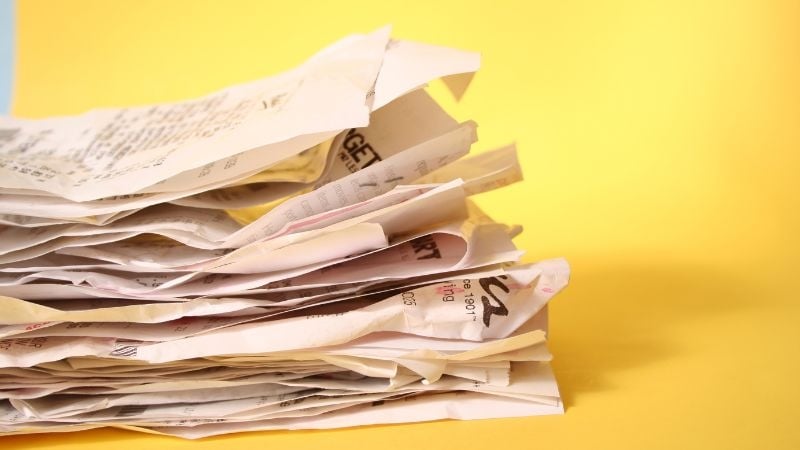
Image credit: Kameleon007 via Canva Pro
If you end up spending extra money because of the delay, say on food, hotel stays, or alternative transport, keep all your receipts. It’s also worth noting information about your conversations with airline staff and any reference numbers or case IDs.
This paper trail will be useful if you want to submit a claim to the airline or your travel insurer later on.
Step 6: Check if you’re entitled to compensation
Depending on your route, you may have legal rights to compensation. For instance, if your flight departs from the European Union (or the UK) and is delayed by more than three hours, or cancelled without proper notice, you might be entitled to cash compensation under EU Regulation 261/2004.
This applies even if you’re flying with a non-EU airline, like Scoot or Singapore Airlines, as long as the departure point is within the EU. The compensation can range from €250 to €600, depending on the length of your flight and the delay.
Similarly, some countries like Canada or the US have their own passenger rights frameworks. If you’re unsure, check the applicable rules for your origin and destination.
Step 7: Contact your travel insurance provider
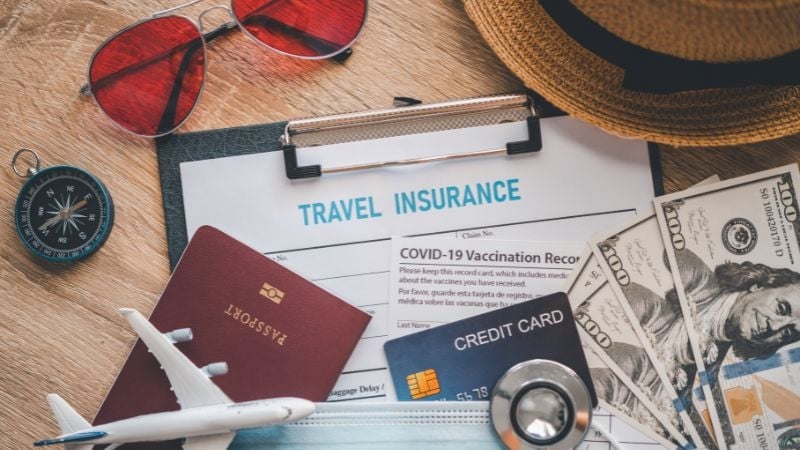
Image credit: photobyphotoboy via Canva Pro
If you’ve purchased travel insurance (and you absolutely should), this is the time to use it. Many policies cover:
- Trip delays and cancellations
- Missed connections
- Emergency accommodation
- Non-refundable bookings, like hotel stays or tours
Contact your insurer as soon as possible to begin the claims process. They will ask for supporting documents, so be ready to provide your flight confirmation, disruption details, receipts, and any written statements from the airline.
Step 8: Follow up after your trip
Even if things were resolved on the spot, it’s a good idea to follow up with the airline once you’re back home. You might want to:
- Request a disruption statement
- Claim reimbursement for expenses
- Enquire about goodwill compensation or vouchers
Many airlines have online portals for post-travel issues, and responses are often faster when you submit requests in writing.
Airline-Specific Information for Singapore Travellers
Flying with Singapore Airlines or Scoot? Here’s what to expect when things go off track:
Singapore Airlines
As a full-service carrier, Singapore Airlines generally offers a smooth experience when it comes to handling delays and cancellations. Passengers can expect the option to rebook or receive a full refund in the event of a flight cancellation. For significant delays, Singapore Airlines typically provides meals, hotel accommodation (if overnight), and transport where necessary.
- Rebooking and refunds: If your flight is cancelled, you can opt for a full refund or rebooking on an alternative flight.
- Flight disruption statements: These can be requested if your flight is delayed by more than 15 minutes or significantly rerouted. They’re helpful for insurance claims and are available up to 6 months after the scheduled departure.
- Refund timeline: Refunds may take up to 6 weeks to process, so be patient or follow up if it’s taking longer.
- EU compensation: For flights departing from the EU, Singapore Airlines complies with EU Regulation 261/2004, which includes compensation for significant delays or cancellations.
Scoot
As a budget carrier, Scoot is known for offering affordable fares, but this can come with trade-offs when it comes to delays, disruptions, and refunds. Scoot does provide rebooking, flight credits, or refunds in cases of flight cancellations or delays over two hours, but travellers should note that processing refunds may take time and require some perseverance. Here are their official policies:
- Delays and cancellations: For flights delayed by 2 hours or more, or cancelled with less than 24‑hour notice (due to “controllable reasons” such as operational or technical issues), passengers are entitled to:
- Rebook on another flight within 14 days, at no extra cost
- Receive a full refund to the original payment method or accept a 120% travel voucher
- EU compensation: Like Singapore Airlines, Scoot also honours EU261 for flights departing from the EU, which means you may be eligible for cash compensation in case of long delays or cancellations.
- Missed connections: If your Scoot flight delay causes you to miss a connecting Scoot service, the airline will rebook you at no extra cost.
As always, just be meticulous in saving booking and cancellation details, and follow up politely but consistently if you haven’t received a response after a few days. As policies and response times may vary depending on the situation, be sure to refer to Scoot’s latest travel advisories and terms for the most accurate and up-to-date guidance.
Also read: What Can You Actually Bring on Board in Your Carry-On Baggage?
You got this
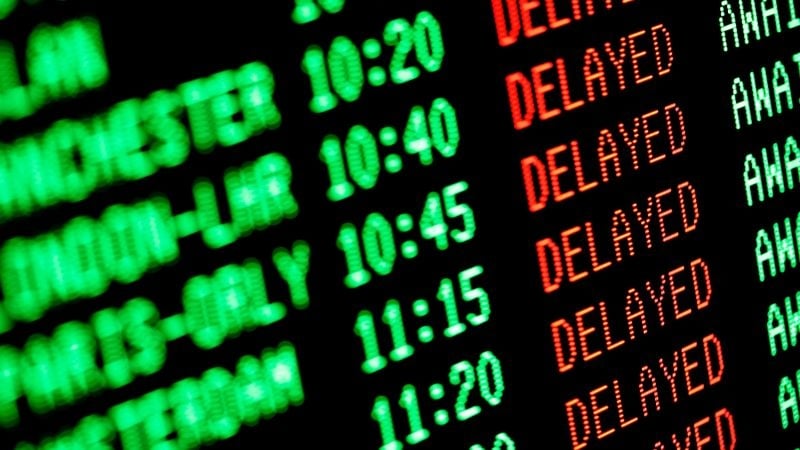
Image credit: bunhill via Canva Pro
Flight delays and cancellations are never ideal, but being equipped with the right information can make all the difference. From knowing your rights to acting swiftly, these steps will help you stay in control.
Next time you’re at the airport and the departure board shows the dreaded “DELAYED” or “CANCELLED”, take a breath and follow these steps.




